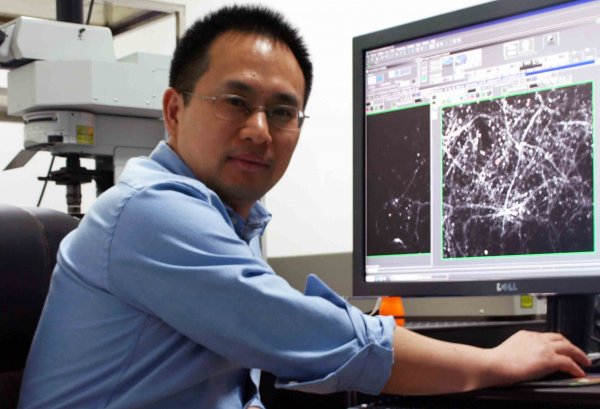
张胜祥
个人简历
科研成果
教学情况
研究方向
论文专著
个人简历
基本信息
职称:教授
办公室地址:天演楼447
办公室电话:0931-8915607
联系电话: 0931-8915607
邮箱:sxzhang@lzu.edu.cn
学习经历
2007-2009 美国纽约大学, Skirball生物分子医学研究所,博士后
2007-2009 Postdoctoral training, New York University
2001-2007 加拿大不列颠哥伦比亚大学,脑研究中心,博士
2001-2007 Ph. D., The University of British Columbia
1995-1998 6163银河.net163.am,生物系,硕士
1995-1998 M.S., Department of Biology, Lanzhou University
1991-1995 6163银河.net163.am,生物系,学士
1991-1995 B.S., Department of Biology, Lanzhou University
工作经历
2009-现在 6163银河.net163.am,6163银河.net163.am,动物学与生物医学系,萃英特聘教授
2009-Present School of Life Sciences, Lanzhou University
2007-2009 美国纽约大学, Skirball生物分子医学研究所,博士后
2007-2009 Skirball Institute of Biomolecular Medicine, New York University
1998-2000 南京大学,生物系,助教
1998-2000 Department of Biology, Nanjing University
社会工作
中国神经科学学会理事,中国微循环学会神经保护与康复专业委员会委员,甘肃省动物学会副理事长,甘肃省细胞生物学学会理事,甘肃实验动物产业技术创新战略联盟常务理事
科研成果
主持基金项目:
主持国家自然科学基金面上项目4项, 甘肃省科技计划项目-科技支撑计划1项,高等学校博士学科点专项科研基金-博导类项目1项,神经科学国家重点实验室开放课题2项;
教学情况
指导研究生:
硕士研究生招生方向:发育神经生物学;
注:硕士研究生招生专业为发育生物学(071008)
博士研究生招生方向:发育神经生物学、动物生理学。
教学:
主讲本科生课程:发育生物学;
主讲研究生课程:发育生物学研究方法,动物生理学专题等。
研究方向
1、脑中风后突触结构可塑性的细胞和分子机理。突触是神经元之间的连接点,是学习和记忆的结构基础。课题组主要研究方向之一是探讨脑中风后影响突触结构可塑性的细胞和分子机理。课题组利用转基因荧光小鼠,活体内双光子荧光显微成像和内源性光学信号成像等技术,以及细胞生物学、分子生物学和行为学等研究方法,尝试揭示病理条件下神经环路的改变与大脑功能恢复之间的关系。
2、小胶质细胞激活和增殖的调控机制。小胶质细胞是中枢神经系统内具有免疫功能的细胞。在正常脑组织中,小胶质细胞处于静息态,对周围的组织起着监测和保护作用。在病理情况下,小胶质细胞被迅速激活,并在损伤区周围增生。课题组目前的兴趣主要是利用多种转基因工具鼠,结合活体成像和细胞培养等手段探讨脑中风后小胶质细胞增生的功能及调控机制。
3、生物荧光标记技术开发与应用。适于活细胞及活体标记的荧光探针的开发,血管标记及成像技术的开发与应用。
4、陇药活性成分作用机制研究。陇药活性成分作用机制研究及其在重大疑难疾病中的应用。
论文专著
Publications:
For most recent publications, please visit my ORCID profile: https://orcid.org/0000-0001-6524-9673
Xie, W., Gong, X.T., Cheng, X., Cao, J., Zhao, J., Zhang, H.L. & Zhang, S. (2021) LIMPID: a versatile method for visualization of brain vascular networks. Biomaterials Science.
Yang, Y.P., Qi, F.J., Qian, Y.P., Bao, X.Z., Zhang, H.C., Ma, B., Dai, F., Zhang, S.X. & Zhou, B. (2021) Developing Push-Pull Hydroxylphenylpolyenylpyridinium Chromophores as Ratiometric Two-Photon Fluorescent Probes for Cellular and Intravital Imaging of Mitochondrial NQO1. Analytical Chemistry 93:2385-2393.
Li, T., Zhao, J., Xie, W., Yuan, W., Guo, J., Pang, S., Gan, W.B., Gomez-Nicola, D. & Zhang, S. (2021) Specific depletion of resident microglia in the early stage of stroke reduces cerebral ischemic damage. Journal of Neuroinflammation 18:81.
Hu, G., Zhong, M., Zhao, J., Gao, H., Gan, L., Zhang, H., Zhang, S. & Fang, J. (2021) Fluorescent Probes for Imaging Protein Disulfides in Live Organisms. ACS Sensors 6:1384-1391.
Roth, S., Cao, J., Singh, V., Tiedt, S., Hundeshagen, G., Li, T., Boehme, J.D., Chauhan, D., Zhu, J., Ricci, A., Gorka, O., Asare, Y., Yang, J., Lopez, M.S., Rehberg, M., Bruder, D., Zhang, S., Gross, O., Dichgans, M., Hornung, V. & Liesz, A. (2021) Post-injury immunosuppression and secondary infections are caused by an AIM2 inflammasome-driven signaling cascade. Immunity.
Wang, L., Zhu, L., Liu, J. & Zhang, S. (2020) Long-term high-resolution in vivo imaging of cerebral cortical structures following ischemic stroke. Biophysics Reports 6:127-136.
Liu, X., Shang, S., Chu, W., Ma, L., Jiang, C., Ding, Y., Wang, J., Zhang, S. & Shao, B. (2020) Astragaloside IV ameliorates radiation-induced senescence via antioxidative mechanism. Journal of Pharmacy and Pharmacology 72:1110-1118.
Zhao, J., Qu, Y., Gao, H., Zhong, M., Li, X., Zhang, F., Chen, Y., Gan, L., Hu, G., Zhang, H., Zhang, S. & Fang, J. (2020) Loss of thioredoxin reductase function in a mouse stroke model disclosed by a two-photon fluorescent probe. Chemical Communications (Cambridge, England) 56:14075-14078.
Long, Y., Liu, J., Tian, D., Dai, F., Zhang, S. & Zhou, B. (2020) Cooperation of ESIPT and ICT Processes in the Designed 2-(2'-Hydroxyphenyl)benzothiazole Derivative: A Near-Infrared Two-Photon Fluorescent Probe with a Large Stokes Shift for the Detection of Cysteine and Its Application in Biological Environments. Analytical Chemistry 92:14236-14243.
Gong, X.T., Xie, W., Cao, J.J., Zhang, S., Pu, K. & Zhang, H.L. (2020) NIR-emitting semiconducting polymer nanoparticles for in vivo two-photon vascular imaging. Biomaterials Science 8:2666-2672.
Zhang, S. (2019) Microglial activation after ischaemic stroke. Stroke and Vascular Neurology 4:71-74.
Ju, F., Ran, Y., Zhu, L., Cheng, X., Gao, H., Xi, X., Yang, Z. & Zhang, S. (2018) Increased BBB Permeability Enhances Activation of Microglia and Exacerbates Loss of Dendritic Spines After Transient Global Cerebral Ischemia. Frontiers in Cellular Neuroscience 12:236.
Zhu, L., Wang, L., Ju, F., Khan, A., Cheng, X. & Zhang, S. (2017) Reversible recovery of neuronal structures depends on the degree of neuronal damage after global cerebral ischemia in mice. Experimental Neurology 289:1-8.
Zhu, L., Wang, L., Ju, F., Ran, Y., Wang, C. & Zhang, S. (2017) Transient global cerebral ischemia induces rapid and sustained reorganization of synaptic structures. Journal of Cerebral Blood Flow and Metabolism 37:2756-2767.
Khan, A., Ju, F., Xie, W., Tariq Hafeez, M., Cheng, X., Yang, Z., Zhu, L., Li, T. & Zhang, S. (2017) Transcriptomic analysis reveals differential activation of microglial genes after ischemic stroke in mice. Neuroscience 348:212-227.
Wang, C., Tao, S., Fang, Y., Guo, J., Zhu, L. & Zhang, S. (2016) Infiltrating cells from host brain restore the microglial population in grafted cortical tissue. Scientific Reports 6:33080.
Li, L., Du, Y., Ju, F., Ma, S. & Zhang, S. (2016) Calcium plays a key role in paraoxon-induced apoptosis in EL4 cells by regulating both endoplasmic reticulum- and mitochondria-associated pathways. Toxicology Mechanisms and Methods 26:211-20.
Li, T. & Zhang, S. (2016) Microgliosis in the Injured Brain: Infiltrating Cells and Reactive Microglia Both Play a Role. Neuroscientist 22:165-70.
Li, D., Guo, J., Zhou, X., Chang, C. & Zhang, S. (2016) The complete mitochondrial genome of Phrynocephalus helioscopus (Reptilia, Squamata, Agamidae). Mitochondrial DNA A DNA Mapp Seq Anal 27:1846-7.
Sun, C.-L., Liao, Q., Li, T., Li, J., Jiang, J.-Q., Xu, Z.-Z., Wang, X.-D., Shen, R., Bai, D.-C., Wang, Q., Zhang, S.-X., Fu, H.-B. & Zhang, H.-L. (2015) Rational design of small indolic squaraine dyes with large two-photon absorption cross section. Chemical Science 6:761-769.
Tang, P., Zhang, Y., Chen, C., Ji, X., Ju, F., Liu, X., Gan, W.B., He, Z., Zhang, S., Li, W. & Zhang, L. (2015) In vivo two-photon imaging of axonal dieback, blood flow, and calcium influx with methylprednisolone therapy after spinal cord injury. Scientific Reports 5:9691.
Wang, Y., Wang, Q., Lv, S. & Zhang, S. (2015) Different protein of Echinococcus granulosus stimulates dendritic induced immune response. Parasitology 142:879-89.
Zhang, Y., Zhang, L., Ji, X., Pang, M., Ju, F., Zhang, J., Li, W., Zhang, S., He, Z., Gan, W.B. & Tang, P. (2015) Two-photon microscopy as a tool to investigate the therapeutic time window of methylprednisolone in a mouse spinal cord injury model. Restorative Neurology and Neuroscience 33:291-300.
Liu, C.J., Du, B., Liu, N.F., Bao, S.J. & Zhang, S. (2014) Sex-specific parental care strategies via nestling age: females pay more attention to nestling demands than males do in the horned lark, Eremophila alpestris. Zoological Science 31:348-52.
Li, T., Pang, S., Yu, Y., Wu, X., Guo, J. & Zhang, S. (2013) Proliferation of parenchymal microglia is the main source of microgliosis after ischaemic stroke. Brain 136:3578-88.
Wang, J., Feng, X., Du, Y., Wang, L. & Zhang, S. (2013) Combination treatment with progesterone and rehabilitation training further promotes behavioral recovery after acute ischemic stroke in mice. Restorative Neurology and Neuroscience 31:487-99.
Lu, B., Li, T., Zhao, H., Li, X., Gao, C., Zhang, S. & Xie, E. (2012) Graphene-based composite materials beneficial to wound healing. Nanoscale 4:2978-82.
Zhang, S., Wang, J. & Wang, L. (2010) Structural plasticity of dendritic spines. Frontiers in Biology 5:48-58.
Bhatt, D.H., Zhang, S. & Gan, W.B. (2009) Dendritic spine dynamics. Annual Review of Physiology 71:261-82.
Zhang, S. & Murphy, T.H. (2007) Imaging the impact of cortical microcirculation on synaptic structure and sensory-evoked hemodynamic responses in vivo. PLoS Biology 5:e119.
Enright, L.E., Zhang, S. & Murphy, T.H. (2007) Fine mapping of the spatial relationship between acute ischemia and dendritic structure indicates selective vulnerability of layer V neuron dendritic tufts within single neurons in vivo. Journal of Cerebral Blood Flow and Metabolism 27:1185-200.
Zhang, S., Boyd, J., Delaney, K. & Murphy, T.H. (2005) Rapid reversible changes in dendritic spine structure in vivo gated by the degree of ischemia. Journal of Neuroscience 25:5333-8.
Zhang, S. & Murphy, T.H. (2004) Ca(2+)-independent spine dynamics in cultured hippocampal neurons. Molecular and Cellular Neurosciences 25:334-44.




